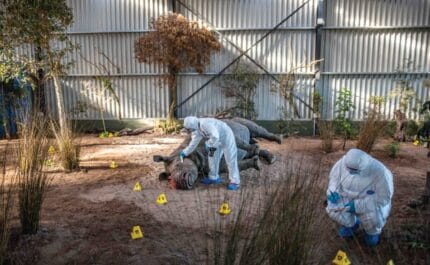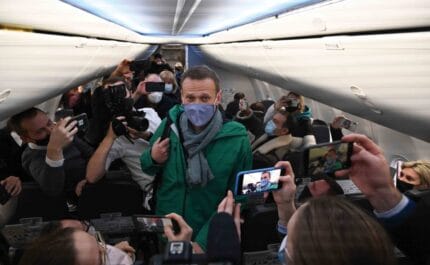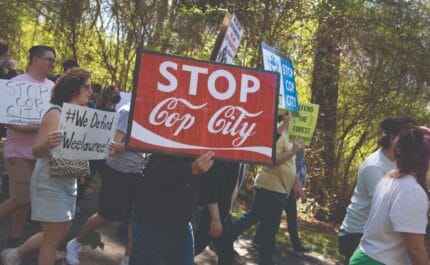In search of a signal
On 3rd April 2015, the lives of the residents of Numbi in the DRC were revolutionised with the flick of a switch on a mobile phone mast. Susan Schulman was there to document the transformation
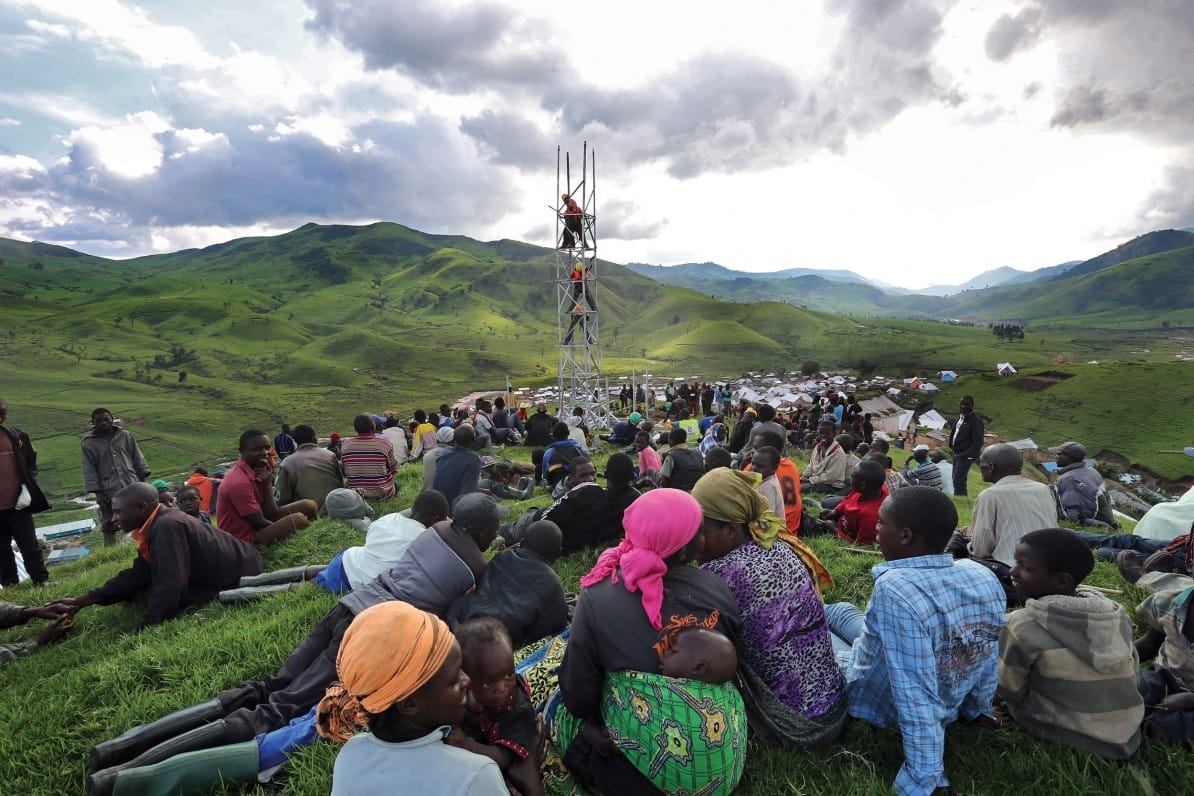
Photography: Susan Schulman
3rd April 2015 (Taken from: #19)
It’s 3am and I want to sleep. Instead I’ve got earphones in and I’m turning up the volume to max as an episode of the TV series Scandal plays on my iPad. It’s not enough. The walls at the Hotel Dieu Merci are not really walls at all but white plasticised tarpaulin stretched loosely across a thin frame, structurally so unsound that the whole building trembles as if struck by an earthquake with each movement. And even the overheated melodrama of Scandal is not enough to drown out the insistent rhythm of energetic intercourse from the room next door.
The Dieu Merci, as it turns out, is not just the only hotel in town. It is also the local brothel.
I am in Numbi, a muddy, Wild West-style mining town in the Haut-Plateau region of South Kivu, deep in the troubled east of the Democratic Republic of the Congo (DRC). I have accompanied a team of engineers on a tortuous 27-kilometre route over steep mountains and taken a room in this rickety bordello so that I can be present for a momentous occasion: their installation of a portable, solar-powered tower that will bring mobile phone reception to Numbi for the first time ever.

A man in Kalunga digs out the wheels of the truck carrying the parts of the mobile phone tower
The DRC is one of the world’s most underdeveloped countries. Although it has vast mineral riches, it ranks second to last on the UN’s Human Development Index. Only 2,250 kilometres of paved roads serve a country the size of Western Europe – in comparison, Luxembourg has 2,899 – and only four percent of the rural population has electricity. The lack of development has stunted growth in health, economy and security, and with neither roads nor communication, the majority of people in the vast countryside live in isolation. Nowhere is this more true than in the DRC’s east, where conflict and insecurity have claimed five million lives since 1996 and armed militias prey with impunity on a powerless population.
In this context, the arrival of mobile phone reception is of extraordinary importance. It means new lines of communication to family, security services, doctors, education and commerce as well as potentially transformative development. But bringing a signal to communities with no road access or electricity through terrain thick with armed militias comes with outsized – bordering, at times, on impossible – challenges.
Johan Ayres knew all this. During his ten years working for South African telecommunications company Vodacom in the DRC’s capital, Kinshasa, he became familiar with the desperate circumstances faced by the Congolese living in rural isolation. Convinced that phone reception would be of immeasurable benefit, and determined that the many technical and logistical obstacles could be surmounted, he conceived a plan to bring it to far-flung communities across the country. Vodacom’s Rural Coverage Sites (RCS) was born. The programme launched in October 2013 and by April 2015, 500 towns and villages throughout the DRC had received phone coverage for the first time.
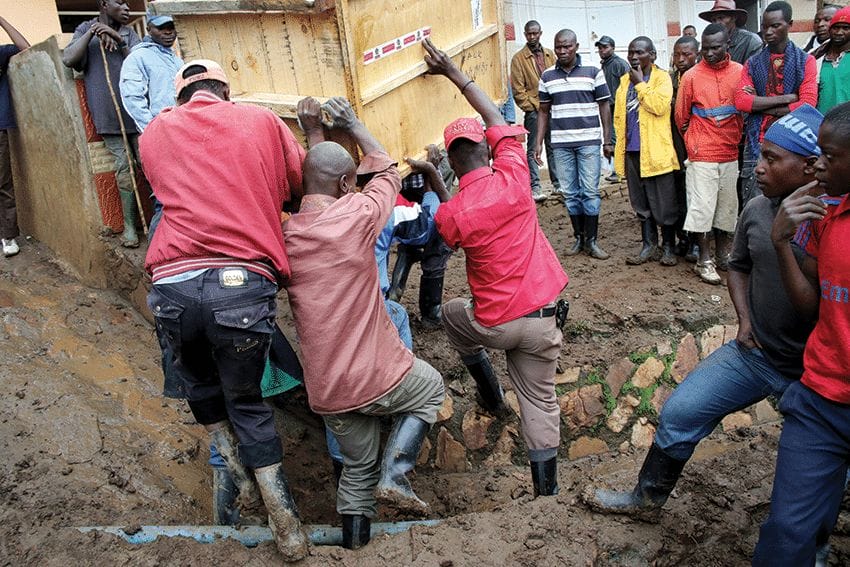
Men in Kalunga battle against the weight of the equipment and the thick, slippery mud underfoot as they unload the truck
The absence of both roads and electricity necessitated design innovation. Imagination, not financial calculation, drove the research and development process. Parts and technology designed for other purposes and made all over the world were repackaged to create a unique, solar-powered, portable mobile phone mast. To create each mast, six state of the art solar panels are attached to four 52 kilo batteries which provide power to an 18 metre-high tower and bring reception within a five kilometre range. Unlike urban mobile phone technology which bounces off other towers in the area, this is an autonomous system that communicates directly with a satellite. Along with mobile phone reception it also brings internet and the M-Pesa system of transferring money using mobile phones, popular throughout much of sub-Saharan Africa.
The local populations of the villages receiving the towers are paid to transport them. They carry the parts up mountains, float them down rivers and wheel them on bicycles through heavily forested terrain. These are 19th century journeys bringing 21st century technology.
The journey to Tango Four
 Getting to Numbi was an epic task. Like most of Congo’s rural villages, it is off the grid. There is no electricity or phone reception and the only way in is via a serpentine dirt track around the mountains. A 10 tonne truck carrying the parts went as far as it could before the road ran out at the town of Kalunga where, due to incessant rain, the roads had been churned into oceans of mud. The truck quickly became bogged down: a barefoot local man shovelled to free its wheels so it could be moved the last 50 metres to its final destination where it would be offloaded.
Getting to Numbi was an epic task. Like most of Congo’s rural villages, it is off the grid. There is no electricity or phone reception and the only way in is via a serpentine dirt track around the mountains. A 10 tonne truck carrying the parts went as far as it could before the road ran out at the town of Kalunga where, due to incessant rain, the roads had been churned into oceans of mud. The truck quickly became bogged down: a barefoot local man shovelled to free its wheels so it could be moved the last 50 metres to its final destination where it would be offloaded.
Kalunga was the final town where there was phone reception, a market and links to transport and the region’s cities. All the valuable minerals coming from the mines pass through here, as does anyone heading for Numbi.
The news that Numbi was going to get phone reception was common knowledge locally and the source of fevered discussion. A Vodacom team attempted to get there the previous week but was attacked by armed bandits and had to turn back.

The long trek to Numbi, carrying heavy kit on steep paths thick with mud
Sebastian Murwanashaka, 35, is a motorcycle taxi driver who plies the Numbi-Kalunga route regularly, transporting passengers and up to 100 kilos of minerals. “It is a dangerous route, with bandits always lying in wait,” he told me. “You must have at least 10,000 francs (£7) to give them or they’ll beat you and then make you say thank you.” He paused and glanced around before adding softly, “to put Vodacom at Numbi is a good thing for the people but the militias do not want it.”
The only way to get the tower from Kalunga to Numbi was by foot. That meant that 2,660 kilos of parts would have to be carried over 27 mountainous kilometres. A crowd gathered as the truck was unloaded, piece by piece, into the hands of local men who struggled not to buckle under the weight or slip on the glistening mud underfoot. Heavy 6×4 foot angled steel panels, bulky batteries and delicate solar panels were swiftly filtered through the busy market crowds and taken off towards the hills beyond.
The decision was made to try to take me and the ten-strong Vodacom installation team up in a 4×4 pick-up. Locals looked askance. The road is considered virtually impassable. It swiftly became clear why: as we drove up the narrow track out of Kalunga, our wheels fishtailed in the thick mud, propelling the vehicle terrifyingly close to the edge, where the slope peeled straight down the mountainside before lurching into a deep gully without so much as a blade of grass to stop a fall.
2,660 kilos of parts would have to be carried over 27 mountainous kilometres”
When the vehicle got stuck, my translator Adolphe and I got out and set off on foot, protected by a Congolese army soldier who happened to be going our way. I was sure the vehicle would catch us up before too long. But it didn’t.
The footpath went straight up, taking what appeared to be the steepest possible route over the mountain. Women hauling huge sacks suspended from their foreheads and with small babies hanging on their chests overtook us while I struggled to put one foot in front of the other. One severe incline followed another, endlessly, tortuously.
At last, exhausted, we arrived at the summit, and were stunned to find that the porters carrying the 2,660 kilos of equipment had beaten us up there. The world spread out spectacularly at our feet, distant Lake Kivu gleaming in the sunshine that pierced the clouds hanging below us. An ant trail of people followed in our footsteps up the mountain. In the other direction, towards Numbi, verdant green peaks arched to the horizon, with not a village in sight.
This was Tango Four, a small wooden farmhouse perched on the top of the mountain with a million dollar view. It was here that the porters from Kalunga were scheduled to hand over the precious equipment to men from Numbi who would continue the trek. But the men hadn’t turned up. As the tower designed to bring reception lay in bits at his feet in the middle of nowhere, Vodacom’s Stéphane Bukulu waved his mobile around trying to find a vagrant phone signal. The irony was lost on no one.
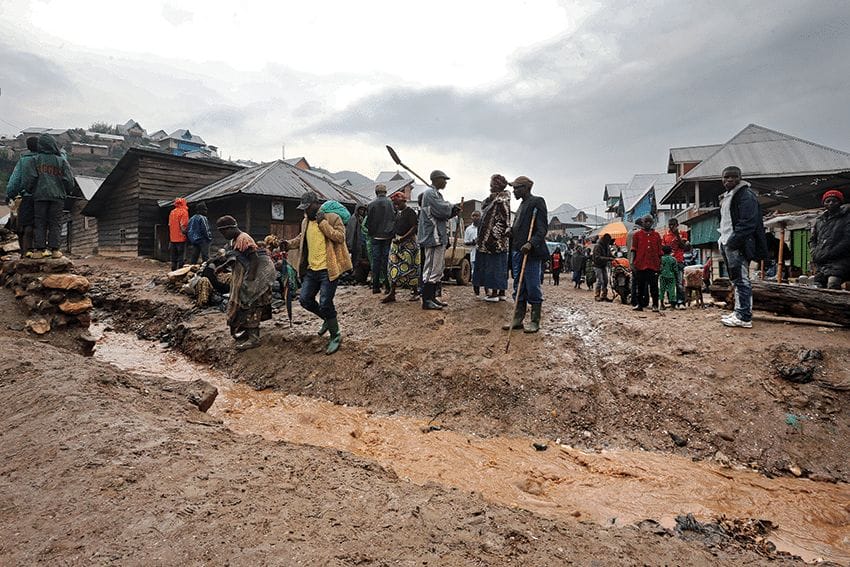
The centre of Numbi
The final stretch
The men from Numbi never arrived. When word got out, a replacement crew materialised from a group who’d been hanging out around Tango Four, and we set off again.
The path was narrower and rougher on the far side of the mountain and fog had added a fresh layer of moisture to the already slippery path. Soon after setting out, one of the four men carrying steel panels on their heads slipped and fell at a shallow ledge. The heavy panel dropped, slamming into his head as he fell. Momentarily stunned, he rubbed his head before springing quickly back to his feet, lifting his load to his head and insisting he was unharmed. Work is virtually non existent in these parts and this was a well-paid gig. He feared losing his job.
As Numbi comes into view it looks pretty decent: as you enter, the illusion of prosperity peels away”
The terrain swooped up and down, bisected by rivers, and the men travelled at pace, teeth gritted and sweat pouring off them, pausing only when they lost a foothold crossing rough waters or mounting slippery banks. On the crest of a hill, alone in the vast, empty landscape, two Congolese soldiers in ill-fitting raincoats, AK-47s slung over their shoulders and brightly coloured umbrellas in their hands, watched transfixed as the parade of parts passed.
Numbi is surrounded by mines which yield tourmaline, coltan, gold and cassiterite for the miners who have flocked here. As it finally comes into view, it looks like a pretty decent place: as you descend towards the town you see multicoloured wooden houses with angular rooftops of corrugated iron. But as you enter, the illusion of prosperity peels away. Children dressed in rags, women hauling 50-kilo sacks and old and crippled men trudge through streets thick with mud before arriving at the filthy, fast-flowing waterway that cuts through the centre of town. There is no bridge: it is a perilous obstacle that has to be negotiated by locals every day.
The only vehicle we saw coming through town carried its own bridge to traverse the river. It was an NGO delivering water. Despite the torrential rains which come every night – this is one of the DRC’s rainiest areas – and thanks in part to 20 years of intense local mining, there is no dependable clean supply of drinking water.
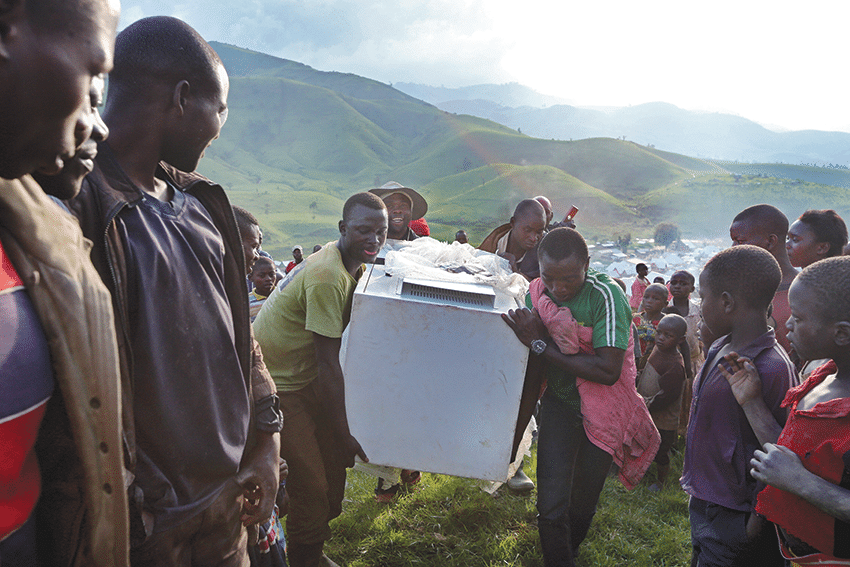
A heavy piece of kit arrives up the final hill on the approach to the installation site
“It is as though we’re in a coffin”
Like much of eastern DRC, Numbi has been plagued by conflict, armed groups, bandits and persistent insecurity since 1996. The vast resources are alluring and the lack of road access combined with the absence of communication have created an isolation conducive to the reign of armed actors. It is a lethal combination.
“We have a serious problem,” says Dr Pascal, 30, who arrived six months ago from Bukavu, South Kivu’s capital, to work at the small health centre in Numbi. He speaks as if he still cannot quite grasp the magnitude of the local situation. “We are unconnected to the rest of the world. No radio, no cellphones – it is as though we are in a coffin,” he declares. “‘There’s insecurity here, but as no one has a way to communicate with each other, you can’t reach anyone for help. Without telephones, with the roads impassable – picture being attacked and you can’t call anyone.”
Insecurity isn’t the only issue. There are potentially grave health consequences to Numbi’s isolation too. “Imagine a woman in the labour room and she is seriously bleeding. If you were connected you could call for help but you’re not so you can’t. It is very frustrating.’’
Cell phone reception is a real weapon against violence and armed groups”
Maitre Nziago came to Numbi 15 years ago to take up the post of headteacher at the local primary school. He is 48, but looks a decade older. “I have been attacked many times. Many people here have been,” he tells me with a sigh. A blue rosary sits next to a toothbrush in front of him on a crude wooden table, the only other piece of furniture in a one-roomed, dirt floor home which does not look like that of a salaried headteacher. “Getting robbed is not the only reason for the poverty here but it certainly contributes,” he says sadly.
Attacks and robberies in Numbi are brazenly planned in public by armed militias on walkie-talkies, dubbed ‘Motorolas’. The details of operations are blasted out loud and clear for everyone to hear, taunting those who lack the means to do anything about it. At the exorbitant cost of $80, ‘Motorolas’ are inaccessible to the overwhelming majority of people here.
Mobile phone reception will help turn the tables. With local leaders and police just a phone call away, overheard plans can be safely communicated, averted and the plotters turned in. Maitre Nziago sums it up succinctly: “I believe cell phone reception is a real weapon against violence and armed groups.”

The installation of the tower draws a big crowd
Soleil Bagira, a 19-year-old mother of four who minds a small pharmacy, sounds a note of caution. “The criminals will be using the network too, so making plans of attack is going to be easier for them,” she says. “Most people are happy about reception but everyone is also worried as the armed groups will also have access.”
Security isn’t only a worry for the locals. It is a challenge for the installation teams. Technician Eustach Muderwa has been installing the RCS in the DRC’s troubled east since the programme’s launch. The locations are the problem, he says, not the work. He has lost count of how many times he and the team have been attacked travelling to remote sites in militia-infested countryside.
The miracle of Haut-Plateau
Launch day begins inauspiciously with heavy rain. The bright blue Vodacom banner suspended from the side of the
Hotel Dieu Merci droops sorrowfully. A salesman huddles for shelter under the striped umbrella of a kiosk set up in front of Restaurant Salama and tries in vain to interest passers-by in Vodacom credit as they trudge through the mud.
Undaunted by the weather, a stream of people makes its way up a narrow path nestled between rows of shops and up towards the tower site. A growing crowd watches with craned necks as the installation rises from the earth. One businessman takes advantage of the captive audience to hawk lanterns and multicoloured underwear from a hand-held display carousel.
The technicians, led by Muderwa, insert strut after strut, assembling the steel mast with grace and speed and climbing ever higher up their creation. Their yellow helmets and hi-vis vests become bright specks, minuscule against the vast and hilly landscape. Along with mobile phone reception, the Vodacom service will also bring web access. But isolation has left Numbi decades behind the modern world and mentioning the internet to people in the crowd elicits only blank stares.
The sun is setting and the moon is pale in the eastern sky by the time the work is complete. A collective gasp ripples through the crowd as the technicians insert the final links and clamber down the tower. “We are about to see a miracle here!” exclaims Richard Sengimani, 34, president of the Société Civile du Haut-Plateau.

Locals celebrate as they gain mobile phone reception for the first time
At last, reception. The town erupts in celebration. Smiles plaster every face, women dance, phones – previously only operational in Kalunga – are pressed to ears. Crowds swamp the Vodacom kiosk and, within five minutes of being turned on, the network jams from overuse.
The system is not perfect. The range is limited and because the mast is solar powered, too many successive days of cloud cover or rain will result in reception outages. But for people who have had to walk for hours to catch a signal in the past, the launch is nothing short of transformative. Local leaders from all the villages in the area have come to implore Vodacom’s team to install towers in their communities.
It is satisfying work despite the risks, says Muderwa. “After I finish an installation I feel proud, and the people are so happy. The installations contribute to both the people and the country.” The figures back him up. There is a proven link between internet access and GDP growth and on a continent where an individual phone is normally used by four people, the benefits of reception can be expected to multiply exponentially.
Between equipment and labour, Vodacom does not expect the average installation cost per site of $50,000 to turn a profit any time soon. But community development, not profit, was the priority and the company is pushing ahead with plans to bring reception to another 500 isolated communities in the coming months.
Just 36 hours after reception comes to Numbi, there are promising signs. Congolese soldier Nzete Ya Mbila calls Vodacom’s Stéphane Bukulu from his remote mountaintop post. “’We are so very happy to have reception. The network has already improved security,” he exclaims. “Now we can call our chief, get information in real time and react. It is the start of a new era!”
Slow Journalism in your inbox, plus infographics, offers and more: sign up for the free DG newsletter. Sign me up
Thanks for signing up.
